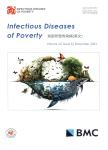China’s 1-3-7 surveillance and response strategy for malaria elimination: Is case reporting, investigation and foci response happening according to plan?
作者机构:National Institute of Parasitic DiseasesChinese Center for Disease Control and PreventionKey Laboratory of Parasite and Vector BiologyMOHWHO Collaborating Centre for Tropic DiseasesNational Center for International Research on Tropical Diseases207 Rui Jin Er RoadShanghai200025People’s Republic of China Global Malaria ProgrammeWorld Health Organization20 Avenue AppiaCH-1211Geneva 27Switzerland Special Programme for Research and Training in Tropical Diseases(TDR)20 Avenue AppiaCH-1211Geneva 27Switzerland Médecins Sans FrontieresBrussels Operational CentreLuxembourgLuxembourg International Union Against Tuberculosis and Lung DiseaseParisFrance
出 版 物:《Infectious Diseases of Poverty》 (贫困所致传染病(英文))
年 卷 期:2015年第4卷第1期
页 面:465-473页
核心收录:
学科分类:1004[医学-公共卫生与预防医学(可授医学、理学学位)] 1002[医学-临床医学] 1001[医学-基础医学(可授医学、理学学位)] 10[医学]
基 金:This research was conducted through the Structured Operational Research and Training Initiative(SORT IT),a global partnership led by the Special Programme for Research and Training in Tropical Diseases at the World Health Organization(WHO/TDR).The model is based on a course developed jointly by the International Union Against Tuberculosis and Lung Disease(The Union)and Medécins sans Frontières(MSF).The specific SORT IT programme which resulted in this publication was jointly developed and implemented by:The Centre for Operational Research,The Union,Paris,France The Operational Research Unit(LUXOR),Medécins Sans Frontières,Brussels Operational Center,Luxembourg The Union,South-East Asia Regional Office,New Delhi,India and The Centre for International Health,University of Bergen,Norway The programme was supported and funded by Asia Pacific Malaria Elimination Network(APMEN,Grant 108-06),Bloomberg Philanthropies,The Union,MSF,the Department for International Development(DFID),UK and the World Health Organization.La Fondation Veuve Emile Metz-Tesch supported open access publications costs.The funders except for APMEN had no role in study design,data collection and analysis,decision to publish,or preparation of the manuscript.APMEN support the data collection and data analysis.
主 题:1-3-7 strategy Malaria elimination Surveillance and response
摘 要:Background:The China’s 1-3-7 strategy was initiated and extensively adopted in different types of counties(geographic regions)for reporting of malaria cases within 1 day,their confirmation and investigation within 3 days,and the appropriate public health response to prevent further transmission within 7 days.Assessing the level of compliance to the 1-3-7 strategy at the county level is a first step towards determining whether the surveillance and response strategy is happening according to plan.This study assessed if the time-bound targets of the 1-3-7 strategy were being sustained over time.Such information would be useful to improve implementation of the 1-3-7 strategy in China.Methods:This cross-sectional study involved country-wide programmatic data for the period January 1st 2013 to June 30th 2014.Data variables were extracted from the national malaria information system and included socio-demographic information,type of county,date of diagnosis,date of reporting,date of case investigation,case classification(indigenous,or imported,or unknown),focus investigation,date of reactive case detection(RACD),and date of indoor residual spraying(IRS).Summary statistics and proportions were used and comparisons between groups were assessed using the chi-square test.Level of significance was set at a P-value≤0.05.Results:Of a total of 5,688 malaria cases from 731 counties,there were 55(1%)indigenous cases(only in Type 1 and Type 2 counties)and 5,633(99%)imported cases from all types of counties.There was no delay in reporting malaria cases by type of county.In terms of case investigation,97.5%cases were investigated within 3 days with the proportion of delays(1.5%)in type 2 counties,being significantly lower than type 1 counties(4.1%).Regarding active foci,96.4%were treated by RACD and/or IRS.Conclusions:The performance of 1-3-7 strategy was encouraging but identified some challenges that if addressed can further improve implementation.



